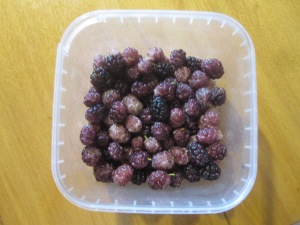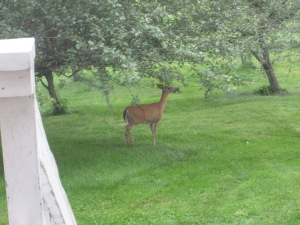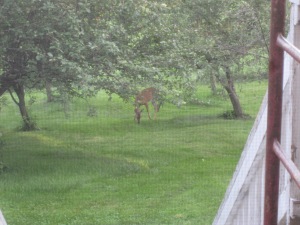Fall Raspberries and Black Walnuts
October 2, 2022
This afternoon I reluctantly took a large plastic bowl off the counter, put on my boots, hat and vest, and headed for the berry patch. This chore has been ongoing since September 2nd, a full month.
It was a beautiful, cold fall day. The loaded raspberry bushes bounced merrily around in the unaccustomed east wind, but I persevered, scooping handfuls of them into the broad, light container. The patch is a 3′ wide row, 50′ long. That’s a lot of picking, it turns out, especially late in the season when the bushes maximize their production until the frost kills them and you mow them down. Then they grow anew in the spring, only to begin the cycle again on the first of September.
The best thing about cold weather berry picking is that the insects are largely absent, (except for lady bugs today). Another tasty thing is that over-ripe berries don’t ferment the way they do in summer. Instead they turn a dark red and wait for the picker to devour their sweetness as his reward. It was a tasty afternoon, with 3 3/4 pounds of raspberries for the freezer, left over from my feast.
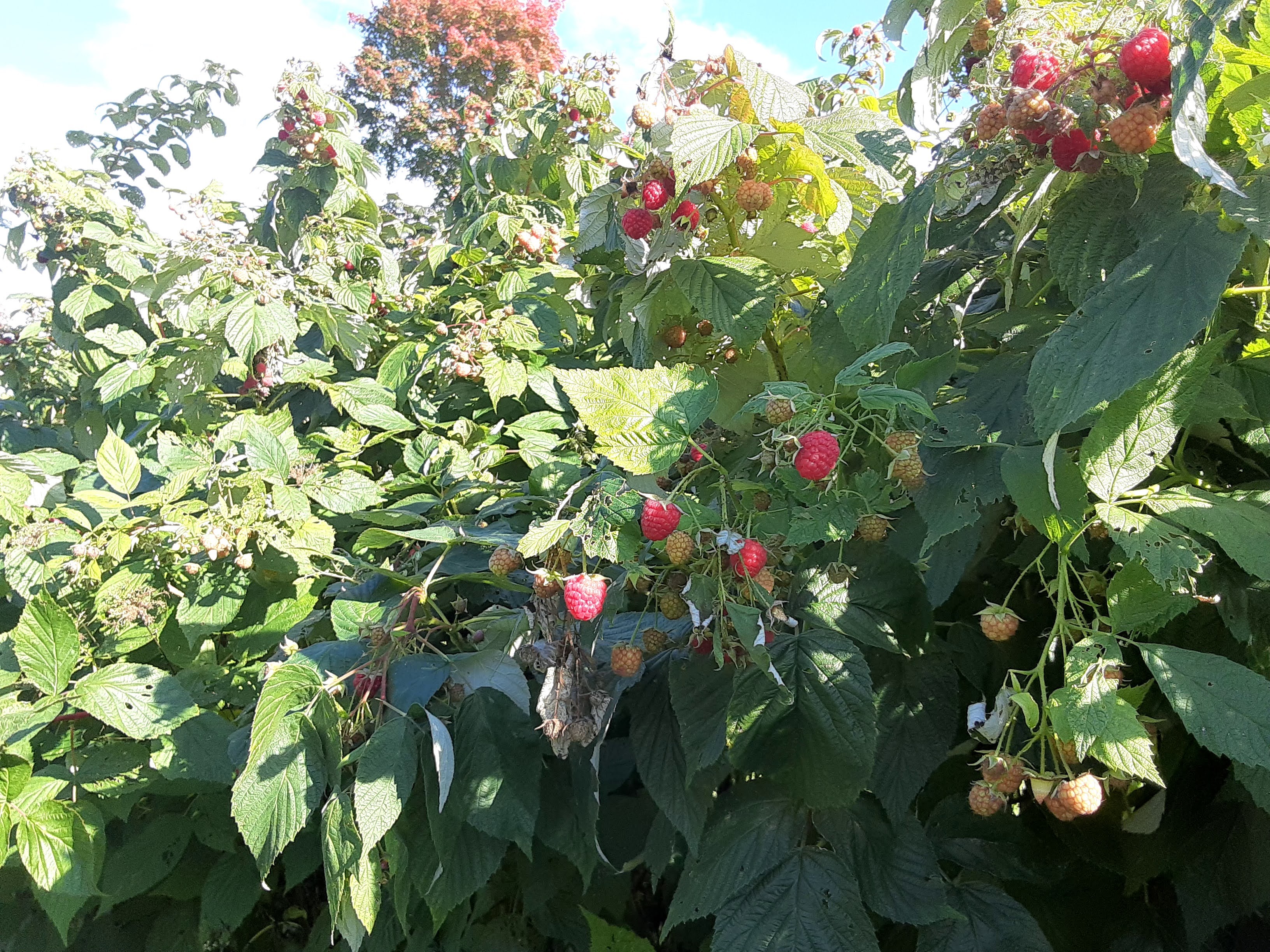
That’s a maple in fall colours in the background, btw.
I have written regularly in this space about my ongoing battles with red squirrels, and how I take a measure of revenge by raiding their nut caches. This year the devious little fellows relocated the cache I had such fun raiding last year. It is now 250 yards south of the other one, and somewhat better concealed. In fact, I blundered onto it by accident while trying to figure out if all of the walnut trees in the woodlot had taken the year off from nut production. In any case, I picked up six, five-gallon pails of nuts because it looked to be slim pickings this year. Even the every-year bearer at the house seems low on nuts because the neighbouring trees are barren, there are no nuts in my two, four acre nut orchards, and the five acre pine/walnut field has only one producing tree.
There must have been a late frost which caught them. Even temperatures a couple of degrees above freezing will kill the flowers. The tree at the house is protected from frost on a still night by the chimney of the furnace. Two regular-bearers back the lane are very old and tall. Their upper branches seem to miss low-lying fogs.
So in their turn I dumped four pails of nuts into my cement mixer, with streams of water and a few round stones. I borrowed my neighbour’s drying tray and prepared the extra piece of mesh to cover the nuts. In went the nuts. On went the mesh. Then I loaded the package onto the bucket of an old tractor, drove it out into an open field, and raised the loader up above my head.
The squirrels are still worried about red tails and harriers, not to mention the odd fox and coyote, all of which love a squirrel dinner. The nuts should dry in peace.
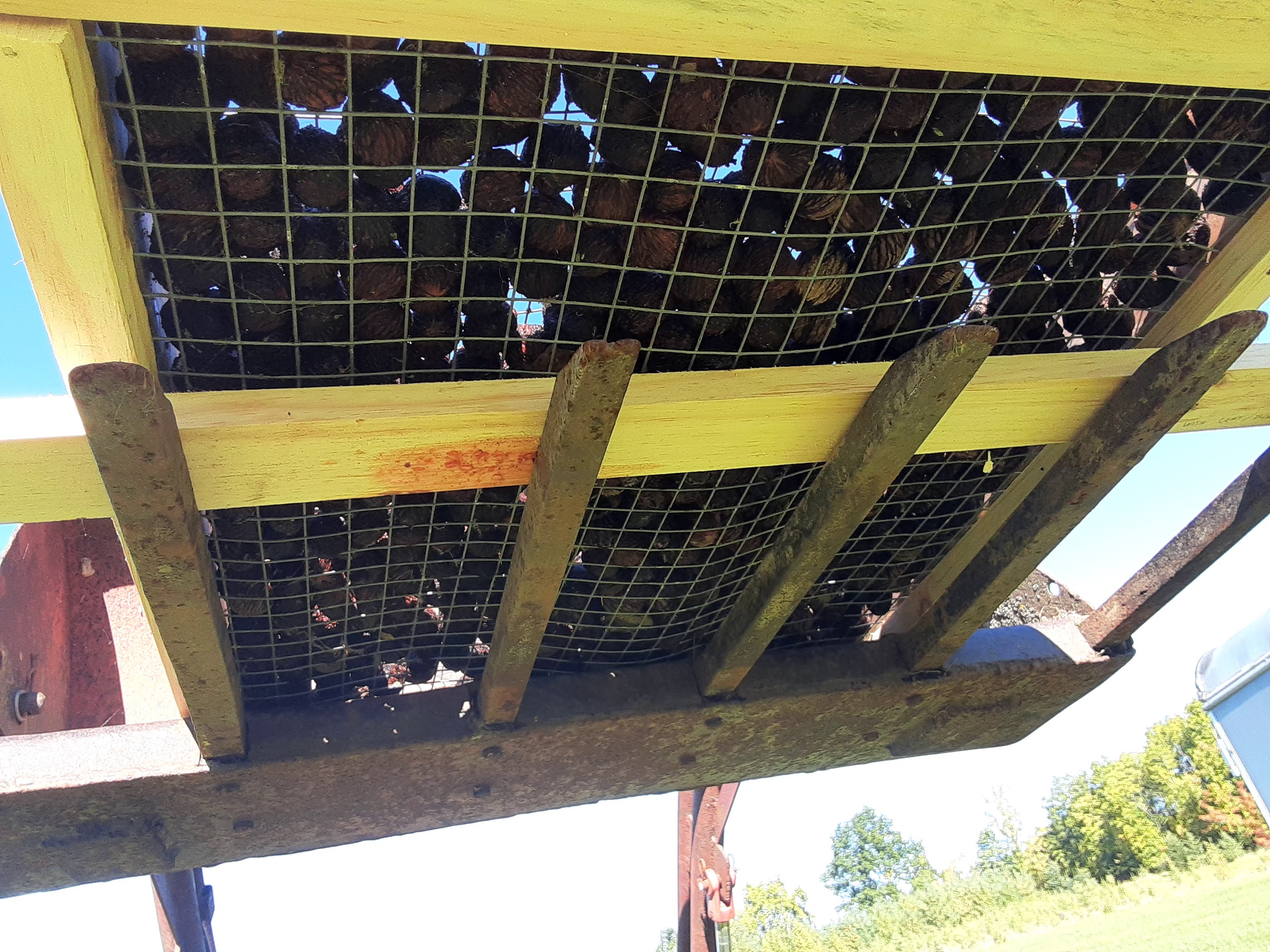
For the Love of Black Walnuts
December 10, 2021
In November our woodlot underwent an audit to requalify for the FSC rating. Glen Prevost at that time suggested that I contact the Ontario Woodlot Association. They asked me to do a film about the managed woodlot over the years. My son Charlie ran the cameras and I talked. The film dropped on December 3rd, though it is still hard to find in You-Tube’s archives.
Here is a link:
The film finally dropped on YouTube on December 12, and since then has accrued 500 views.
Planting walnuts
December 3, 2017
It was a perfect day for it this afternoon, so after our walk I grabbed the “Nut Wizard” Tom Stutzman gave me a while ago and had at the matt of blackened hulls under the walnut tree in the orchard. In no time a five gallon pail was full of mostly-hulled black walnut seeds, perfect for planting.
Over the years I have observed that black walnuts grow best from seed planted in late fall, and they’ll grow tall and straight if they have to struggle to get to sunlight because of competition from overhanging trees. The shelter belt of white pines on the north side of the property has quite a few young walnuts fighting their way to the top of the canopy, giving the hope of long, clear, veneer logs in sixty years. The nearest mature walnut tree is a half-mile away. Never underestimate the ambition and the horticultural talent of a grey squirrel.
For the last two years in November a pine-boughs merchant has sent a crew in to trim the lower branches of my white pines as they mature. The foliage ends up in a variety of Christmas decorations resold by vendors in the Toronto area. This activity enables the businessman to keep his construction crew working for an additional month in fall. They’re pretty good guys and they care about the trees. Ministry of Natural Resources personnel approve of this trimming procedure as it encourages the growth of higher-quality logs.
These five guys had spent a month walking around the stand of pine, so the grass was well packed for easy planting between existing stems. I kept a careful eye out for the shagbark hickory, yellow birch, and various oaks planted in clumps along with the pine. I left them to grow on their own, but I interplanted walnuts between the pines, every second row.
On an earlier planting project MNR Forester Gary Nielson told me that the black walnuts will eventually kill the pines and we’ll end up with a hardwood forest. That’s the theory: the pines are a nurse crop.
So on this lovely afternoon in late fall I picked my way down the long rows of healthy, seven-year-old pine saplings, pushing walnuts into the soft ground with my custom black-walnut planting stick. I put one in about every twenty feet. After I’d stomped 137 nuts into the turf the stained pockets of my oldest coat were empty and I decided to leave the remainder of the seeds for another day.
Should anyone care to try this pleasant task, I’d be happy to show you where to gather nuts. Be sure to wear gloves. While there is zero risk of infection from the walnuts because the rotting hulls are a powerful antibiotic, the dye contained in the dark mush will stain your hands so as to give you the once-in-a-lifetime experience of “seal flipper.” Donna O’Connor told me that high test gasoline will remove the stain, but I have yet to try it.
Frost
May 24, 2015
Friday night (May 22nd, 2015) the temperature dropped below freezing for several hours. The next day was cold and very windy. The frost, or the frost combined with cold, dry winds, did considerable damage to the foliage and flowers of various trees and seedlings scattered about the property.
The most obvious victims were young green ash saplings. By Saturday afternoon the five-year-old ashes beside the brook had turned completely black, stems and all. The damage in a stand of green ash and silver maple planted in 2006 was entirely restricted to the ash. They showed moderate defoliation on some lower branches. All maples seemed to hold up well to frost.
White birch seedlings planted two years ago (2013) showed little frost damage despite rapid growth this season. Their escape might have to do with their height. Seedlings under a foot of height were hardest hit.
Shagbark hickory leaves on 2010 seedlings showed extensive damage. Pin oaks varied: the more verdant the recent growth, the more leaf damage. Slightly older red oaks showed red leaves, but no shriveling.
Black cherry saplings transplanted to the front lawn showed no damage.
Mulberries on the lawn have shriveled leaves, but the undeveloped seeds seem intact, if slightly discoloured. This applies to both the red mulberry trees and the hybrid which produces freakishly sweet, mauve mulberries.
2012 black walnut seedlings were whacked by the frost. That’s no surprise, for I looked at 7 acres of 2005 walnuts and only the most sheltered have the bulk of their leaves intact. One relatively exposed plot of 2006 butternuts will have to grow new leaves, a trick these trees do anyway in response to insect attacks. The adjoining black walnuts planted in the fall of 2005 have heavily damaged foliage, as well.
The real question remains whether the apples, pears, and the producing black walnut tree which lie in the shelter of the house will bear fruit this year. I suspect that the presence of two furnaces running nearby on the night of the frost may have created a micro-clime to allow their flowers to survive. Time will tell.
A note about weeds might be in order. Buckhorn seems impervious to frost. I detected no frost damage to the dreaded wild parsnip which I spent Friday and Saturday spraying. Wild cucumbers and the more verdant climbing vines suffered greatly in the frost, but the robust climbing vines soldier on.
Apart from the green ash, the showiest sufferers were 2013 Norway Spruce seedlings. They had been having a great spring, but the new growth is now brown and dessicated. White spruce and white pines, like maples, seem to have suffered not at all.
Prince Edward County Revisited
August 19, 2013
At the age of five I climbed to the top of a huge sand dune on the edge of Lake Ontario and then attempted to run down it. As I recall I spent the remainder of the trip to the Picton Sandbanks trying to flush sand out of my eyes, nose and ears.
Some years later on August 20, 1972, my bride and I drove from Kingston to the Sandbanks on a one-day honeymoon before we returned to our summer jobs in Ottawa. Students, eh?
It seemed fitting this year that we attempt to recreate that journey. Bet admitted that she remembered very little of our brief honeymoon. I was sure that we drove our red VW Beetle, found the Picton beach, if not the sand banks, and made it back to Ottawa in time for work on Monday.
I wished I had that Beetle to drive on a road trip one more time, but our gray Lexus would have to do for now. Bet insisted upon taking our spaniel along for the ride.
My bride of 41 years had prepared a fine picnic lunch the day before, so we drained the dog and loaded up the Lexus on a glorious August day. Our son Charlie knew not what he asked when he borrowed my portable navigation system to aid his drive from Seattle to Victoria for a wedding on the weekend. At Bet’s insistence I asked my computer for directions to the Sandbanks. Google Maps commented: “Go to Trenton and turn left.” I tried for a more sophisticated itinerary, but when it offered a path that cut through Battersea and Inverary I decided to rely upon my own (unused of late) navigation skills.
We found the park after a spectacular drive across the island from Deseronto. Things went pretty well until we had finished a delicious picnic lunch well away from the beach. Dogs are not permitted on the sand or in the water. But lunch went well, once we found a picnic table without discarded rib bones on the ground below. Taffy’s quite the scrounger.
By the way, the beach looks to be flat-out beautiful. I peeked over the hill for a few photos, then headed off in search of wine country.
Near the park exit I cornered a woman on a recumbent bike and asked her whether I should turn right or left to find a winery. She rose to the challenge and actually produced a cycling map combined with a blizzard of instructions, so off we went, driving the charming back roads in the vicinity of the Sandbanks Provincial Park. Somehow we doubled back. Twice. Fine. I recognized our mistake. Off we went again, this time branching off into farming country.
We happened upon a number of vineyards. To my surprise they seemed to be situated on some of the less arable farmland in the area. Much of the vegetation we saw I didn’t recognize. Oh yes, goldenrod and sumacs were everywhere, but I didn’t see any dreaded wild parsnip or buckhorn, and Bet commented that she only saw purple loosestrife as we drew near to Belleville. One very common stunted evergreen is a mystery to me, though it grows in profusion on poor soil to the west of Kingston. I couldn’t identify the tree under which we ate lunch. Some kind of ash? Ash crossed with Manitoba Maple? The trees are different there.
To judge from the height and girth of some well-established lawn specimens, black walnuts do well in this area. They’re heavy stems with straight, muscular branches, like the ones on our property in Forfar, not the spindly trunks and willowy branches which surprised me in the wine country south of Lake Erie.
My purpose in visiting the wine district was to get an idea of growing conditions in the area. I suspected from the placement of the vineyards near the lake that they depend upon the unfrozen lake’s moderating influence throughout the winter.
At one well-financed vineyard we saw a pair of huge propellers erected on towers above the vines, no doubt to help fend off the frost on chilly spring nights.
The vineyards show conspicuous effort and investment on the part of their growers and we must have driven past a dozen separate operations in the area south of Belleville.
But I wanted ice cream and we were in the middle of nowhere. Driven my sweet tooth I tried to find our way out to civilization – Belleville and the 401 in this case.
My navigation instincts had completely broken down from sugar deprivation by the time we tried to make our way through Belleville. Without my trusty Tom Tom I found myself lost more than I liked. Finally I sidled the car up to a stopped pickup truck and two embarrassed guys sent us back two miles to a Tim Horton’s to make the turn to the 401.
Not having the Tom Tom cost us at least an additional hour of driving and disturbed those guys talking in that Chevy pickup. When we stopped at a popular takeout in Barriefield for Greek food for supper, we discovered it had been replaced by a pet food vendor. More backtracking. But I guess we can’t blame the Tom Tom for a restaurant closing.
In all (counting getting lost in wine country as a positive), it was a pleasant drive. I commented to Bet: “If you want to sell a couple a Lexus, give them the keys and send them to tour Prince Edward County. The car is made for days like this.”
“No walnut twig-boring beetles yet,” MNR.
August 6, 2013
For two summers MNR technicians have maintained an insect trap amid the black walnut trees on our property. The task was to locate examples of the walnut twig-boring beetle, a known vector for the thousand cankers disease which is currently devastating black walnut stands in the American South.
I just spoke to the technician. She told me that they soon plan to remove the trap because they haven’t found any of the dreaded critter. There are lots of butternut twig-boring beetles, but no walnut.
Needless to say I liked this news.
How to blackmail a mulberry tree
July 4, 2013
It was just a little shrub growing at the side of the garden, a bit in the way but not too bad. All summer I had avoided it, then one day the mower reached out and flattened it. Oops. Oh well, there are lots of mulberries, both red and white, growing wild at the farm.
But it popped back up, looking horrid. So I backed over it to put it out of its misery. Further mangled, it doggedly resisted the diesel mower’s three spinning blades and rose tentatively from the sod again. I left it for a forthcoming session with the hand-held brush cutter, but then forgot the thing.
A year later it surprised me with a handful of extremely sweet mulberries which were a pale mauve colour.
I’d never seen mulberries of that mauve colour, ripe or unripe.
There’d been a large white mulberry near the house until I cut it up and burned it as firewood. It blocked my mother’s view of the road and it confused me because there was no way to tell visually if the abundant fruit was green, ripe, or spoiled: all were a pale greenish white. Of course the more common red mulberries are white when formed, progressing to bright red and then to shiny black when ready to eat. Simple. Birds, dogs, raccoons and humans love them.
This year the little tree in the upper garden is loaded with berries ranging from white to black, but the pale mauve fruit are already sweet enough to eat, and actually taste better than the fully ripe deep purple ones. The tree seems to be going all-out to prevent another visit from the mower.
Perhaps stress motivates a fruit tree.
With Emily-the-Wolf absent, this yearling fawn has decided she likes our orchard for twice-daily feeding sessions. She let Bet take a few shots yesterday.
Notes from the nut fall, 2010
September 20, 2010
It looked as though the three nights of frost in late May had done in this year’s walnut crop, but after supper tonight Bet and I gathered about 40 gallons of walnuts from five trees growing together in the woodlot and one in the garden.
The young garden tree yielded 530 nuts (4 white oil-pails full) before I ran out of space and desisted for the evening. That was about 2/3 of the nuts on the ground. The tree still has a lot of nuts on it. I’d call that a best fruiting ever for that young tree. Perhaps it’s because I pruned a large extraneous limb off it last year. Stress seems to encourage walnuts to bear.
Update: 22 September. From the garden tree I gathered another 560 nuts from the ground and low-hanging branches. There are still perhaps 500 nuts on the upper branches of the tree, but they don’t seem ready to fall yet. About fifty nuts lay under the small tree in the shade of the barn, with a few on the upper branches. Competition from the nearby red mulberrry tree and vines crawling over the upper limbs have limited this tree’s productivity. In the woods again there are nuts not yet ready to fall, but I gathered only about 60 more from beneath the clump of frost-evading trees there. A search of the remainder of the woods turned up no more bearing trees, so it looks like a short nutting season in 2010.
